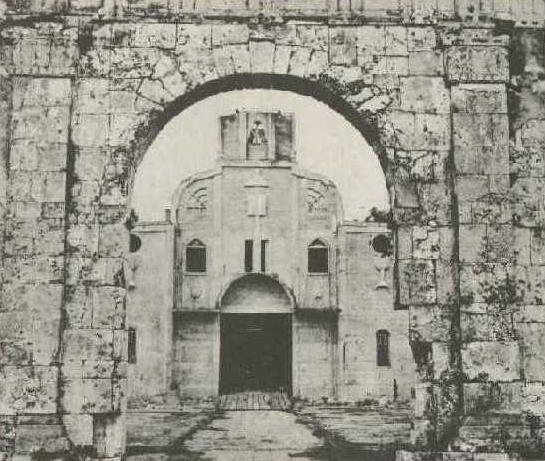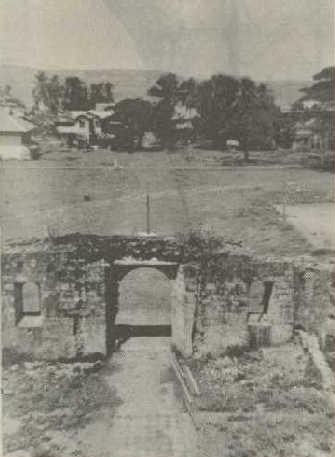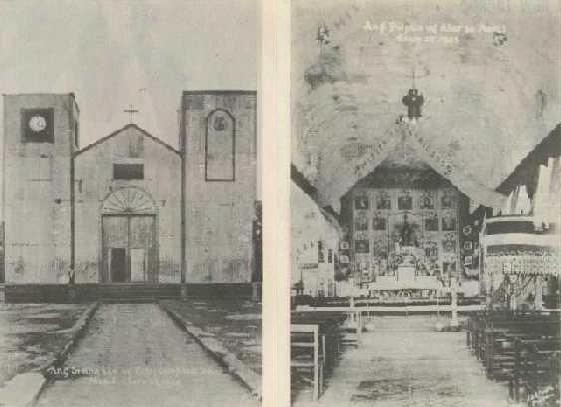NAVAL CHURCH BUILDING
The first known church building in the vicinity of Naval was described by Fr. Pedro Chirino, a Jesuit missionary and chronicler, in a report published in Rome in 1604. The unpublished details of his report were quoted by another Jesuit chronicler, Fr. Francisco Colin, in 1663. This church building was theorized to have been located in the vicinity of Sitio Ilawod in Barangay Caraycaray.
Fr. Colin, citing facts recorded by Father Chirino, mentioned about a church and a convent that were constructed through free labor of the inhabitants. The church had posts and walls made of pampango wood (teak) and had the following dimensions: 27 fathoms (162 feet) in length, 7 fathoms (42 feet) in width, and 3-1/2 fathoms (21 feet) in height.
This church building and its improvements were probably razed during a Moro raid on May 26, 1754, when only two (sic) of the entire inhabitants of Biliran Island were reported to have escaped capture by the raiders.

TWO FACADES. This picture shows two facades of the Naval
Parish Church. The front facade belonged to that of the pre-1900
concrete church, the main building of which was destroyed by a strong typhoon in 1912. The facade that can be seen through the archway belonged to that of the church in the late 1950s. This church building was in turn destroyed to give way for the construction of the present church.

LOST RELIC, LOST SCENERY. This photograph was probably taken in the late 1950s from the window of the choir loft of the church. The scenery has been lost forever. The facade of the pre-1900 church (shown from the back) stood until 1966, when a crane leveled it to the ground, allegedly because this hampered the construction work in the new church. Of course, this structure was not an obstruction. The American Franciscans just had other thoughts in mind.
Across the street from the church facade was the old town plaza, now part of the compound of the Cathedral School of La Naval. Playground demonstrations were held here during fiestas. A small patch of clean ground to the right is part of the local tennis court, which still exists.
The two structures across the plaza to the left are the back portion of an old movie house and the Ecarma house (towards the street). Both buildings are gone.

NAVAL CHURCH IN 1938. These two pictures show the facade and the well-decorated interior of the church, photographed on January 27, 1938. The date fell on a last Thursday of January, a day that coincided with the vesperas of the Naval fiesta in modern times. I am speculating, but these pictures probably marked the first time the town fiesta was ever celebrated on a January, instead of the usual commemoration on the first Sunday of October. The latter is still celebrated with appropriate religious activities, but without the usual fiesta fanfare.
October was at the tail-end of the famine season (tinggutom) in those days, with the rice harvesting season still weeks away. Because of food shortage, our folks therefore could not have a wholesome celebration. Thus, they proposed to the parish priest to move the fiesta to January, just after the planting season when the residents also still have stocks of rice. (Basic information provided by the late Alberto Bago, nephew of Msgr. Felix Sabenicio, parish priest of Naval for 25 years: 1922-1930; 1931-1947.)
Now that there is already food all year round, would it not be fitting to reunite our municipal and religious fiestas in October?

OLD CONVENT. A photograph of the old convent of Naval, located at the corner of Castin and Padre Inocentes Streets, across from the present Botica Velasquez.